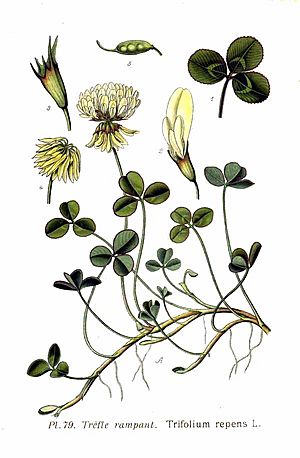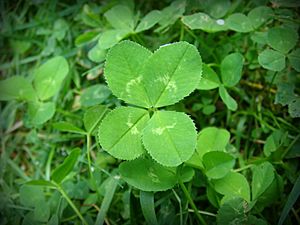White clover facts for kids
Quick facts for kids White clover |
|
|---|---|
 |
|
| Scientific classification | |
| Genus: |
Trifolium
|
| Species: |
repens
|
| Synonyms | |
|
Synonymy
Amoria repens (L.) C.Presl
Lotodes repens Kuntze Trifolium limonium Phil. Trifolium stipitatum Clos Trifolium macrorrhizum Boiss., syn of subsp. macrorrhizum Trifolium nevadense Boiss., syn of var. nevadense Trifolium orbelicum Velen., syn of var. orbelicum Trifolium orphanideum Boiss., syn of var. orphanideum Trifolium biasolettii Steud. & Hochst., syn of subsp. prostratum Trifolium occidentale Coombe, syn of subsp. prostratum |
|
Trifolium repens, also known as white clover, is a plant that lives for many years. It belongs to the Fabaceae family, which is the bean family. This plant originally comes from Europe and central Asia. It is one of the most common types of clover grown by people around the world.
White clover has been brought to many places to be used as food for animals. Now, you can find it in most grassy areas, like lawns and gardens, in North America, Australia, and New Zealand. White clover plants come in different sizes: small, medium, and large. This depends on how long their leaf stalks are. The name 'white clover' is used for the plant in general. 'Dutch clover' often refers to the medium-sized types, and 'ladino clover' is for the large ones.
Contents
What's in a Name?
The name of the plant group, Trifolium, comes from two Latin words. Tres means "three," and folium means "leaf." This is because the leaves usually have three small parts, called leaflets. This is why it's also known as "trefoil."
The second part of its scientific name, repens, is Latin for "creeping." This describes how the plant grows along the ground.
White Clover's Look
White clover is a plant that stays low to the ground. It has round clusters of whitish flowers. These flowers sometimes have a little pink or cream color as they get older. The flower clusters are about 1.5 to 2 centimeters (0.6 to 0.8 inches) wide. They sit on stalks that are about 7 centimeters (2.8 inches) long.
Bumblebees and honey bees often visit these flowers. The leaves have three leaflets, which are smooth and oval-shaped. They usually have light or dark markings on them. The stems of white clover creep along the ground, like stolons. They can grow as much as 18 centimeters (7 inches) a year and grow roots at their joints. The leaves of white clover are often used as the symbol known as shamrock. Most white clover plants have three leaflets, but very rarely, you might find one with four leaflets.
Where White Clover Grows
White clover is native to Europe and Central Asia. It grows everywhere in the British Isles. It has also been brought to places like North America, South Africa, Australia, New Zealand, and Japan. People grow it all over the world to feed farm animals.
How White Clover Is Used
Food for Animals
White clover is a very important plant for feeding animals in cooler parts of the world. It helps the soil by taking nitrogen from the air and putting it into the ground. This means farmers don't need to use as much chemical fertilizer. White clover is often grown with grasses, like perennial ryegrass. This mix is good for animals and can reduce problems like bloat in livestock.
Helping Other Plants Grow
White clover is a good "companion plant." This means it grows well next to other plants, like those in lawns, grain fields, and vegetable gardens. It is often added to lawn seed mixes. This is because it can grow well and keep the ground green even in poor soils where grass might not grow.
White clover can handle being mowed or grazed closely by animals. It can also grow in many different types of soil and at different pH levels. It prefers clay soils. Because it is a legume and a tough plant, it helps keep soil healthy. It adds nitrogen to the soil and can stop weeds from growing. This means less chemical fertilizer is needed, which is good for the environment. For these reasons, it is often used to improve soil as a green manure or cover crop.
Eating White Clover
Besides being great food for farm animals, the leaves and flowers of white clover can be eaten by humans. They are full of proteins and are easy to find. For hundreds of years, fresh white clover plants have been added to salads and other meals. However, they are not easy for humans to digest raw. You can fix this by boiling them for 5 to 10 minutes. Some Native American groups used to eat certain types of clover raw. Dried white clover flowers can also be smoked as a natural alternative to tobacco.
Medicinal Uses
In India, people have used T. repens as a traditional medicine. They believed it helped against worms in the intestines. Some studies have shown that parts of the plant that grow above ground do have properties that can fight certain worms.
Images for kids
See also
 In Spanish: Trébol blanco para niños
In Spanish: Trébol blanco para niños



